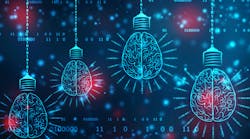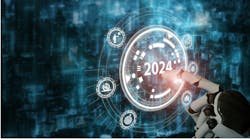We hear a lot about intelligent enterprises, smart operations, smart manufacturing, and so on. But what do the terms “intelligent” and “smart” really mean in these contexts? Is there any difference between them?
Being “smart” is often defined as the generation, processing, and sharing of data. This is the principle behind “smart products” like phones, cars, analytical tools, even city lighting systems.
In the manufacturing environment, my understanding of “intelligent” means “a more advanced level of smartness.” That is, data captured from smart products and their surroundings is contextualized, resulting in the creation of a “best-case scenario.”
Let’s dig deeper. The core of an intelligent or smart factory is often represented by a symbol of a human brain. But let’s compare a factory to a human. All of us have a brain — but should every human be regarded smart or intelligent? Probably not. So just having a brain is not enough.
Being intelligent means having the ability to absorb information (data), contextualize it, process it, and derive a (best)-case scenario from it. It means having the ability to adapt to changing conditions.
In the manufacturing environment, assets and workforces should be regarded as data platforms that generate and consume tremendous volumes of data that are processed by the OT and IT layers.
This is “smart” — but not “intelligent.” Even the utilization of AI and cognitive/machine learning algorithms do not elevate these environments to the realm of the “intelligent.”
Interesting fact: Organizations that implement digital solutions — such as predictive models or condition and performance monitoring — may claim they are using the data to make faster and qualitatively better decisions. But they aren’t leveraging horizontally and vertically.
That is, the more digital solutions they have deployed, the more silos they have created. The element of end-to-end data contextualization is missing. Instead of removing complication and optimizing existing complexity, systems have become even more complex. This may result in an environment that is too complex, complicated, and unstable to tame with one central brain.
What Should an Intelligent Enterprise Look Like?
This strongly depends on the value chain type. Discrete manufacturing organizations with highly complex products tend to be more labor intensive than low-complexity, high-volume producers. Process manufacturing can be operated without a single touch by an operator. Even most back-office processes can be automated.
But for all value chain types, the intelligent core should work as a central brain. To free the intelligent core to work effectively and autonomously, here are the basic prerequisites:
- 100% data-driven processes
- Secure IT and OT environments
- Vertically and horizontally converged systems
- Supply chain and customers integrated into relevant factory infrastructure
- Human interference removed from processes to reduce instability and potential failures (e.g., advanced automation in production and back office)
- Platform-based and scalable IT architecture
- End-to-end decisions made by AI algorithms
- Edge and cloud architecture that handles analytics in real time using significant computing power
What’s the Ideal for the Near Future?
Turning a smart factory into an intelligent enterprise requires much more than leveraging seamless data flow and data-based insights and decision-making. Building an intelligent core that autonomously manages processes requires implementing an advanced level of software and hardware automation, conducting technology setup and maintenance remotely, and the autonomous provision of internal and external logistics.
Achieving this feat may be a long journey. It requires overcoming obstacles, including the replacement of legacy IT and OT systems across all domains, investment in fully automated and flexible production concepts, and high-level protection of the entire system.
Most importantly, total capital and operational expenditures for the project must result in the desired return on investment. For most enterprises, a hybrid human-technology-automation environment is still the best choice for attaining effectiveness and business sustainability.
But such a converged environment is not “intelligent — at least as we have described it above. Perhaps it is best called “more than smart.” That is, it leverages the best of both worlds. It is not fully managed by central AI, but instead combines the human brain’s flexibility, intuition, and ability to understand things in a broader context, with AI’s ability to derive insights based on the analysis of complex data inputs. It is closer to “intelligent,” but not there yet.




